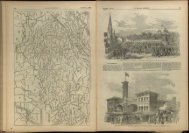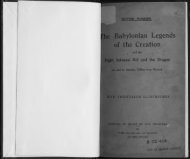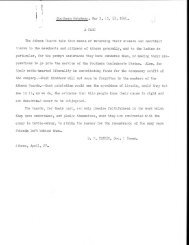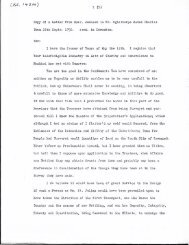THE SHE KING; OR, THE BOOK OF ANCIENT POETRY
THE SHE KING; OR, THE BOOK OF ANCIENT POETRY
THE SHE KING; OR, THE BOOK OF ANCIENT POETRY
You also want an ePaper? Increase the reach of your titles
YUMPU automatically turns print PDFs into web optimized ePapers that Google loves.
\<br />
44 <strong>THE</strong> CHINA <strong>OF</strong> <strong>THE</strong> <strong>BOOK</strong> <strong>OF</strong> POETEf. <strong>THE</strong> CHINA <strong>OF</strong> <strong>THE</strong> <strong>BOOK</strong> <strong>OF</strong> POETET. 45<br />
its boundaries to the south far beyond those of any<br />
former period.<br />
2. In the prolegomena to the Shoo I have mentioned<br />
the extravagant statements of Chinese writers, that at<br />
a great durhar held by Yu the feudal princes amounted<br />
to 10,000 ; that, when the Shang dynasty superseded the<br />
house of Yu, the princes were reduced to about 3000;<br />
and that, when Shang was superseded in its turn by<br />
'Chow, they were only 1773. The absurdity of the<br />
lowest of these numbers cannot be exposed better than<br />
by the fact that the districts into which the empire of<br />
the present day, in all its eighteen provinces, is divided<br />
are not quite 1300. But in the Book of Poetry, as has<br />
been pointed out already, we have odes of only about a<br />
dozen States; and all the States or territorial divisions,<br />
mentioned in the Ch'un Ts'ew and Tso-chnen, including<br />
the outlying regions of Ts'oo, Woo, and Yueh, with<br />
appanages in the royal domain, attached territories in<br />
the larger States, and the barbarous tribes on the east,<br />
west, north, and south, are only 198. In the " Anna-<br />
listic Tables of the successive dynasties," published in<br />
1803, the occurrences in the kingdom of Chow, from its<br />
commencement in B.C. 1121 clown to 403, are arranged<br />
under thirteen States, and from 402 down to its extinc<br />
tion in B.C. 225, under seven States.<br />
The principal States which come before us in the She<br />
states mention- are Ts'in, lying west from the royal domain,<br />
ed in the she. & considerable part of which was granted to<br />
it in B.C. 759 ; Tsin, having the Ho on the west, and<br />
lying to the north of the royal domain ; then to the east,<br />
Wei, on the north of the Ho, and Ch'ing on the south<br />
of it, with Heu and Ch'in extending south from Ch'ing.<br />
East from Ch'ing, and south of the Ho, was Sung, a<br />
dukedom held by descendants of the royal family of the<br />
Shang dynasty. North from Sung was the marquisate<br />
of Ts'aou; and north from it again was Loo, held by<br />
the descendants of Tan, the famous duke of Chow, to<br />
whose political wisdom, as much as to the warlike enter<br />
prise of his brother king Woo, was due the establishment<br />
of the dynasty. Conterminous with the northern border<br />
of Loo, and extending to the waters of what is now<br />
called the gulf of Pih-chih-le, was the powerful State of<br />
Tsre. Yen, mentioned in III. iii. VII. 6, lay north and<br />
east from Ts'e. The subject of that ode is a marquis of<br />
Han, who appears to have played a more noticeable part<br />
in the time of king Seuen, than any of his family who<br />
went before or came after him did. His principality was<br />
on the west of the Ho, covering the present department<br />
of T'ung-chow, Shen-se, and perhaps some adjacent<br />
territory. The ode commences with a reference to the<br />
labours of Yu which made the country capable of cultiva<br />
tion, but much of it must still have been marsh and<br />
forest in the time of king Seuen, for mention is made of<br />
its large streams and meres, and of the multitudes of its<br />
deer, wild-cats, bears, and tigers.<br />
The princes of these States, distinguished among them<br />
selves by the titles of Kung, How, Pih, Tsze, and Nan,<br />
which may most conveniently be expressed by duke,<br />
marquis, earl, count or viscount, and baron, were mostly<br />
Kes, offshoots from the royal stem of Chow. So it was<br />
with those of Loo, Ts'aou, Wei, Ch'ing, Tsiu, Yen, and<br />
Han. Sung, it has been stated, was held by descendants<br />
of the kings of Shang, who were therefore Tszes. The<br />
first marquis of Ts'e, was Shaug-foo, a chief counsellor<br />
and military leader under kings Wan and Woo. He<br />
was a Keang, and would trace his liueage up to the chief<br />
minister of Yaou, as did also the barons of Heu. The<br />
marquises of Ch'in were Kweis, claiming to be descended<br />
from the ancient Shun. The earls of Ts'in were Yings,<br />
and boasted for their ancestor LJih-yih, who appears in<br />
the Shoo, II. i. 22, as forester to Shun. The sacrifices<br />
to Yu, and his descendants, the sovereigns of the He'a<br />
dynasty, were maintained by the lords of Ke, who were<br />
consequently Szes, but that State is not mentioned in the<br />
She.<br />
All these princes held their lands by royal grant at the<br />
commencement of the dynasty, or subsequently. I have<br />
touched slightly on the duties which they owed to the<br />
king of Chow as their suzerain in the prolegomena to<br />
the Shoo, and I do not enter further on them here. A<br />
more appropriate place for exhibiting them, and the re<br />
lations which the States maintained with one another,<br />
will be in the prolegomena to the Chun Ts'ew and the<br />
-Iso-chuen.








